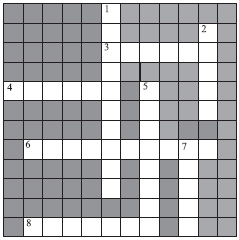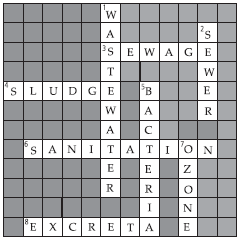Wastewater Story (Biology) Class 7 - NCERT Questions
Fill in the blanks:
(A) Cleaning of water is a process of removing ___________.
(B) Wastewater released by houses is called ___________.
(C) Dried ___________ is used as manure.
(D) Drains get blocked by ___________ and ___________.
(A) pollutants (B) sewage (C) sludge, (D) cooking oil, fats.
Q 2.What is sewage? Explain why it is harmful to discharge untreated sewage into rivers or seas.
SOLUTION:Sewage is a liquid waste. It consists of wastewater from houses, offices, factories, hospitals etc. It is a complex mixture containing suspended solids, organic and inorganic impurities, nutrients, saprotrophic and disease causing bacteria and other microbes.
If the untreated sewage is discharged into rivers and seas, it will cause water pollution and soil pollution, in which both the surface water and ground water get polluted. Ground water is a source of water for wells, tube wells, springs and many rivers. Therefore, if it gets polluted, it becomes the most common route for water-borne diseases like cholera, typhoid, polio, meningitis, malaria, dengue etc.
Why should oils and fats be not released in the drain? Explain.
SOLUTION:Cooking oils and fats should not be thrown down the drain. They can harden and block the pipes. In an open drain, the fats clog the soil pores reducing its effectiveness in filtering water. Oils and fats should be thrown in the dustbin.
Q 4.Describe the steps involved in getting clarified water from wastewater.
SOLUTION:Treatment of wastewater involves physical, chemical, and biological processes, which remove physical, chemical and biological matter that contaminates the wastewater. Following steps are involved in getting clean water by the treatment of wastewater :
1. Bar screens : Wastewater is passed through bar screens which remove large objects like rags, sticks, cans, plastic packets, napkins etc.
2. Grit and sand removal : Water then goes through grit and sand removal tank, where sand, grit, pebbles etc. settle down at the bottom and are removed.
3. Sedimentation tank: Water is then allowed to enter in a tank where solids like faeces (called sludge) settle at the bottom and are removed with a scraper. A skimmer removes the floatable materials like oil and grease. Water so cleared is called clarified water. Sludge is collected in digesters, where it is used to produce biogas.
4. Aerator : Clarified water is then passed through an aerator tank where air is pumped into the water. It helps aerobic bacteria to grow which decompose organic matter like human and animal waste. After several hours, the suspended microbes settle at the bottom of the tank as activated sludge. The water is then removed from the top. The dried activated sludge is used as manure.
5. Chlorination : The treated water has low level of organic material and suspended matter. It is discharged into a sea, a river or into the ground. Sometimes it is disinfected through chemicals like chlorine and ozone before discharging it into water bodies.
What is sludge? Explain how it is treated.
SOLUTION:Sludge is one of the by-products of wastewater treatment along with biogas. Sludge is human waste (like faeces), left during sewage treatment. Since it is organic waste, it is used to produce biogas and manure.
In the clarifier (or sedimentation tank), sludge is settled down at the bottom and is collected by a scraper. It is transferred to a separate tank called digester where it is decomposed by the anaerobic bacteria. The biogas produced in the process can be used as fuel or can be used to produce electricity.
The clarified water from the sedimentation tank is passed into aeration tank. In the aeration tank, the suspended microbes settle down at the bottom as activated sludge. The activated sludge is about 97% water. The water is removed by sand drying beds or machines. Dried sludge is used as manure, returning organic matter and nutrients to the soil.
Untreated human excreta is a health hazard. Explain.
SOLUTION:Human excreta is home for many pathogens and disease causing microbes. If left untreated, it will cause threat to public health. Many water-borne diseases like cholera, diarrhoea, typhoid, polio, meningitis, hepatitis and dysentery are caused due to faecal-oral route. Untreated human excreta may cause water pollution and soil pollution. Both the surface water and ground water get polluted. As ground water is the source of water for wells, tube wells, springs and many rivers, therefore it becomes the most common route for water-borne diseases.
Q 7.Name two chemicals used to disinfect water.
SOLUTION:Chemicals like chlorine and ozone are commonly used to disinfect water.
Q 8.Explain the function of bar screens in a wastewater treatment plant.
SOLUTION:In a wastewater treatment plant, the first step is passing of wastewater through bar screens. Large objects like rags, sticks, cans, plastic packets, napkins etc. are removed through this.
Q 9.Explain the relationship between sanitation and disease.
SOLUTION:There is a direct relationship between sanitation and disease. Poor sanitation and contaminated drinking water is the cause of a large number of diseases. Under poor sanitation, people may resort to defecate in the open, on dry riverbeds, on railway tracks, near fields and even directly in water. Poor sanitation leads to:
– Growth of harmful microbes, flies and mosquitoes, hence spread of many diseases like cholera, typhoid, polio, meningitis, hepatitis and dysentery.
– Pollution of soil and water, which poses health hazards to all the plants, animals, and human beings.
– Both the surface water and ground water get polluted. As ground water is the source of water for wells, tube wells, springs and many rivers, therefore it becomes the most common route for water-borne diseases.
Outline your role as an active citizen in relation to sanitation.
SOLUTION:Wastewater treatment is a costly treatment. It requires costly infrastructure to build and maintain wastewater treatment plants. It is necessary that we should become active citizens and limit the type of waste produced. A few steps which can be followed on our part are listed below:
1. Following better housekeeping practices such as throwing cooking oil and fats, chemicals like paints, medicines etc., used tea leaves, cotton, food remains etc. into dustbin rather than draining them.
2. We should not scatter litter anywhere at public places. If there is no dustbin in sight, we should carry the litter home and throw it into dustbin.
3. We should bring into notice of municipality officials the open drains, leaking pipes, uncovered manholes etc.
4. We should follow the rule of 3R’s i.e., reduce, reuse and recycle.
5. We should make people aware and encourage community practices to keep our environment clean.
Here is a crossword puzzle: Good luck!
Across
 3. Liquid waste products
3. Liquid waste products
4. Solid waste extracted in sewage treatment
6. A word related to hygiene
8. Waste matter discharged from human body
Down
1. Used water
2. A pipe carrying sewage
5. Micro-organisms which cause cholera
7. A chemical to disinfect water
Across
3. Sewage
4. Sludge
6. Sanitation
8. Excreta
Down
1. Wastewater
2. Sewer
5. Bacteria
7. Ozone

Study the following statements about ozone:
(A) It is essential for breathing of living organisms.
(B) It is used to disinfect water.
(C) It absorbs ultraviolet rays.
(D) Its proportion in air is about 3%.
Which of these statements are correct?
(i) (A), (B) and (C) (ii) (B) and (C)
(iii) (A) and (D) (iv) All four
(ii) (B) and (C).